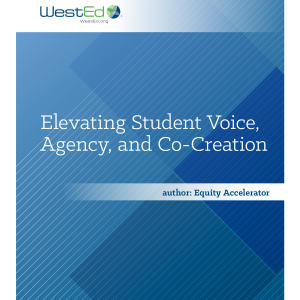Building Community Agendas to Advance Racial Equity
Posted on

By Ursula Wright, Division Director at WestEd and a member of the agency’s senior leadership team. Ursula leads and supports a 300+ person team focused on fulfilling a range of K–12 education needs that bridge policy, research, and educator practice.
Where one resides has a disproportionate influence on how much one will thrive. This simple, evidence-based premise is at the core of place-based initiatives, such as community agendas, which present strategies designed to improve the quality of life in a given community through long-term, locally developed solutions to chronic poverty and inequality. In recent years, many communities across the country have begun to center racial equity in their place-based initiatives because they have developed hypotheses that legitimately tie the root causes of their communities’ barriers to opportunity to structural racism. There is also a growing understanding that true and sustained transformation in communities requires addressing root causes of societal barriers to opportunity rather than merely their symptoms.
At the 2022 Promise Neighborhoods and Full-Service Community Schools National Network Conference, I had the honor of copresenting with Fred Jones, Senior Director of Public Policy & Advocacy at the Southern Education Foundation, during the conference’s closing plenary session. Together, we discussed how to build and use community agendas to accelerate place-based transformation and reduce barriers produced by racial inequities.
What Are Community Agendas?
A community agenda is a plan for addressing complex, large-scale problems within a specific geography wherein community representatives take the lead in creating and implementing the plan to ensure that it addresses the specific needs and context of that community. Full-service community schools and Promise Neighborhoods are two well-established models of how community agendas can be effectively used.
Throughout my more than 15 years working with and for organizations that contribute to transformative community change and sustained impact, I’ve learned that community agendas can be approached in a variety of ways, carry different names, and define success very differently. I’ve also learned that the most successful community agendas feature long-term, integrative strategies and operational structures that tend to possess six core features:
- Shared vision by all involved parties
- Shared accountability among all involved parties
- Shared access to financial resources, information, and relationships
- An enduring team of contributors that is diverse in both identity markers and thought
- A willingness to embrace learning and retire long-held beliefs and preferences
- A comfort with disruption. Transformative change is disruptive by nature. Those who succeed in this work understand that the ways of old helped hold problems in place and the only pathway to transformation involves a permanent change in mindsets, behaviors, and practices.
Leveraging Community Agendas to Advance Racial Equity
Now, let’s center the topic of leveraging community agendas to advance racial equity. Put simply, racial equity is both the process and outcome of eliminating racial disparities such that race is no longer a reliable predictor of academic achievement and life outcomes. It’s not the lifting up of some students at the expense of others, but the work of thoughtfully setting up all students to reach their full social and academic potential.
While the following steps certainly do not make up an exhaustive list, I believe them to be most foundational to initiating and sustaining efforts to strengthen racial equity.
- Seek to understand the root causes of and enabling conditions for racial inequities. Racial inequities are the byproducts of compounded challenges and decisions. Neighborhood disinvestment, discriminatory mortgage lending, and employer policies that undermine family stability are frequently observed culprits. Racial inequity cannot be truly addressed unless its causes are fully understood.
- Be clear and consistent on who is meant by “the community” and what is meant by “racial equity.” Similarly, it is important to make sure all involved parties are on the same page when it comes to understanding which populations you are trying to serve, who should shape and lead the agenda, and how said population defines “racial equity.”
- Study sources of data to understand potential biases and awareness gaps. Data are key to sound decision-making, but too often the sources of data are not interrogated for bias and awareness gaps. Quite a bit of harm has been committed throughout history using uninterrogated data.
- Disaggregate data into demographic groups to surface disparities and potential solutions. Make sure qualitative and quantitative data are disaggregated into specific demographic groups so that patterns, trends, and experiences can be completely understood and comprehensively addressed.
- Be willing to share power and redefine what constitutes “expertise.” Partnering with others in a community—parents, nonprofits, students, businesses, or otherwise—requires a shifting of power, and part of that shift involves the redefinition of expertise.
- Use collective voice to name challenges and facilitate systems remedies. Advancing racial equity requires the courage to explicitly name challenges and facilitate systems remedies. These conversations are not easy, and no one is exempt from the discomfort they may prompt. But a problem cannot be solved without first being acknowledged.
Developing and successfully implementing community agendas has never been an easy feat. The work becomes even more laborious when communities attend to the racial inequities often holding barriers to opportunity in place. But the reward of radically improved academic and life outcomes throughout a community are well worth the hard work. Leaders of community transformation efforts are encouraged to think of this work as a marathon, not a sprint, and to use the guidance above to build their community agendas for advancing racial equity. Our children and their families will be well served by such investments.


